

Wanderfound
-
Posts
4,893 -
Joined
-
Last visited
Content Type
Profiles
Forums
Developer Articles
KSP2 Release Notes
Posts posted by Wanderfound
-
-
Treat it like orbital rendezvous; you need to get close to it and match speed and velocity before attaching. Match inclination and direction (or launch into the correct inclination to start with), use a lower orbit to catch up to it or a higher orbit to let it catch up to you.
It doesn't take too much ÃŽâ€V to get there (relatively speaking; you need enough for the inclination match and to then boost to escape velocity), but it will take a fair bit to capture it. After you've attached, the mass of your craft effectively becomes the mass of the rocket plus the mass of the asteroid. High efficiency engines (LV-N, LV-909, Poodle) are advisable.
-
Parachutes work on Duna, but the atmosphere is low and thin, so you need more of them and they'll deploy frighteningly late.
Slow down as much as you can before deployment (circularise a low orbit before descent, and come in at a very shallow angle to aerobrake on the way down), adjust the tweakables of your chutes to get them open as early as possible, use drogues before the main chute and be prepared to use a bit of thrust at the last moment before touchdown. And reinforce whatever you've attached the parachutes to: moar struts.
-
You don't have to be officially credentialed to get into a journal, but you do need to format it to the journal's standards and convince a group of peer reviewers that your paper is both competently written and makes a significant novel contribution to the field.
Pick out a journal with a low Impact Factor that publishes on this topic, have a look at the other papers in that journal, and look up the submission process.
If you need help, I'd be willing to have a look for you, but be prepared for any critique to be a bit ego-bruising. Peer reviewers are not gentle in their commentary.
This is me: https://sydney.academia.edu/CraigMotbey
-
"Doctor" has become an almost meaningless term. Where once it generally restricted to medical doctors, it now includes those who have completed Ph.D studies or less (chiropractors here are referred to as doctors, though they've only done the equivalent of a master's degree).
You've got the history exactly backwards. See above.
-
A very astute statement unfortunately
 Much experience?
Much experience?Medically retired. I had plenty of funding; the work at the core of my doctoral thesis alone pulled in half a million in grant money. Not that I was any good at politics (that was my Professor's specialty...), but I hit a relatively hot topic [1] at the right time and got in before there'd been any significant prior work on the subject.
[1] 4-methylmethcathinone (AKA mephedrone); mechanism of action, toxicology and potential for addiction.
-
Thanks for the pics!
Your Elevator looks like McDonnell Douglas DC-X. Were you inspired by it?
Thunderbird One, actually. The end result ended up diverging from the original concept a bit.

-
All the above is good advice, but also: practice, practice, practice. Once you get the hang of it you can do it purely by eyeball.
-
Hit Alt-F12 in-game, then enable the difficulty settings you desire. Should do the trick, unless you want some sort of badge on your savegame to make you feel better about yourself.
E: unless this is some sort of in-game mode where you "launch sim" or "launch fo reelz", in which case revert already does what you want, you just need to exercise some self-discipline.
Generally agreed, but there's space for a middle ground as well. Some of the difficulty mods already use it: revert stays enabled, but there's a financial penalty if you use it. Think of it as the expense of running simulation testing.
-
Those are very heavy boosters; they need a good kick to get them clear. If the top is rotating in to strike the core, move the Sepratrons up so that they push the top away. And, as mentioned above, move them out a bit so that the Sepratron exhaust doesn't damage the core.
If you place the Sepratrons right, you won't need to space out the boosters.
And yes, there is a bug at the moment that makes the radial decouplers direct their force lower than it should be. But even without the partial bug fix mentioned above, properly placed Sepratrons will negate the problem.
Incidentally, once you get the hang of Sepratrons, you can do all sorts of tricks with them. You can get your discarded boosters to do pretty acrobatics as they fall if you place them right.
-
WTF?! I think it's compulsory anywhere in the world, i hope they at least make list those "doctors" who chosen not to take Hippocratic oath.
I wouldn't value the Hippocratic Oath that highly, if I were you. If you look at the original text [1] you'll find that a major focus of it was on protecting the income of physicians rather than protecting the welfare of patients.
Most of the ethical stuff is in there because it was common for physicians of the time to do the things that it forbids [2], and Hippocrates was attempting to promote his own students by claiming that they were less dodgy than all of the others. Its primary purpose was advertising.
[1] This section in particular: "To consider dear to me, as my parents, him who taught me this art; to live in common with him and, if necessary, to share my goods with him; To look upon his children as my own brothers, to teach them this art; and that by my teaching, I will impart a knowledge of this art to my own sons, and to my teacher's sons, and to disciples bound by an indenture and oath according to the medical laws, and no others."
[2] Included in the forbidden practices are using surgery to remove gallstones and performing abortions. There are valid reasons for modern medical schools to ditch it.
-
Historically speaking, "Doctor" is the Western equivalent of "Sensei" or "Sifu": it means "teacher". A (real, non-physician, PhD) doctor is someone that's had enough training at an academic discipline that they're qualified not just to do that thing (Master) but also to teach it to others (Doctor).
Around the time of the Renaissance, there was competition between a few different factions in England and western Europe about who were the "real" healers. Physicians studied the theory of medicine, whereas the College of Barber-Surgeons (the "barber" thing was because in Medieval times, the local barber was the one guy who could be relied on to have a good sharp razor) had a more practical and empirical approach. Apothecaries were kind of in between the physicians and the surgeons. Village herbalists and midwives actually did the bulk of the hands-on care for most of the population, but they were generally ignored by the authorities on account of being mostly female peasants.
Physicians went to University where they read (wildly inaccurate and lethally misguided) ancient Greek and Roman books about medicine, whereas Barber-Surgeons were trained by a hands-on apprenticeship. In an attempt to emphasise their academic credentials, the physicians started calling themselves "doctors", even though most of them were only Masters by normal university standards. It's a courtesy title; most PhDs will tell you that physicians aren't really doctors.
This history is also why Anglosphere surgeons are called "mister" instead of "doctor".
--
Dr Wanderfound, PhD.
-
Yeah but that wouldn't be an improvement to the game. There is already enough sit around and wait in this game, waiting on optimal launch conditions would just be irritating.
So don't wait. I'd quite enjoy fighting to keep control of a rocket as it flew through a storm. Part of the reason I have EVE installed is because it's fun to come roaring down through the cloud layer blind only to realise that you're about to whack into the top of a mountain if you don't pull up in time.
More to the point: anything like this should be implemented as a switchable difficulty option. Them that wants it gets it, them that don't won't.
-
Thanks for all the comments, I learned alot! though the plane I need only has to lift about 1ton into LKO. After that the probe itself can get to almost anywhere. The plane I used is alot smaller and barely makes it to orbit.
This one can easily reach orbit with its tanks still half-full. It'd take a bit of modifying to make it into a probe-carrier, but it might be a useful place to start from. Pulling the goo pods and material bays should free up some weight capacity.
-
Looks magnificent! Can you show more pics of it?
I'm limited in screenshots, because the part count is high enough to slow my computer to a crawl, so I've only taken it to orbit once just to make sure it works. I've got a few pics, but many of them are from slightly different versions that I went through while prototyping. But, since you asked:
-
I did a Googlin' and couldn't find anything that is compatible with v0.24.2 of KSP... I even searched these forums, and the Curse page. Came up empty...
Anyone aware of a mod with cargo bays, e.g. for use on a space shuttle orbiter? Preferably with an internal docking node (or at least some way of attaching a dock inside it) so one can use the cargo bay for deploying satellites/spacejunk/detritus?
At the moment, I've resorted to using the cargo bay from the CactEye orbital telescope mod, but the bay itself is too small for carrying any decent-sized payload.
There are medium-small diameter (unlimited length) cargo bays in Spaceplane Plus: http://forum.kerbalspaceprogram.com/threads/80796-0-24-Spaceplane-Plus-1-3
Apart from that, you're mostly down to waiting for the B9 update, fighting with the current version of B9, using Procedural Fairings (works okay, but you can't "close the door" afterwards) or hacking something together yourself from structural panels. If you get onto the design threads, you'll find assorted people doing creative things with landing-leg driven hydraulic doors.
You can also get some decent functionality from open-air cargo bays:
-
Like the efficiency of air-breathing SSTOs, but can't be bothered with all that spaceplane stuff? Got a computer that can handle a moderately chunky part count? Have we got a deal for you...
Ten turbojets and twenty RAPIERs provide all the power you could ever want. Who needs wings? In thrust we trust.
Use the action groups rather than staging, and disable crossfeed on the docking port connecting the lifter to the cargo (self-propelled Rockomax 64 used here as an example) before launch. Action group 8 will disable the RCS on the cargo. Take it vertically to 10,000m then gradually pitch over to 30°. Keep the Vernors off until you need them.
Cautious aerobraking is recommended before descent. Undoubtedly the silliest thing I've ever designed. Handle with care.

https://www.dropbox.com/s/dwjph1dijhr8afn/Kerbodyne%20Elevator%20XS%20Stock.craft
-
BTW: anyone interested in the microgravity vestibular stuff should look at the work coming out of this lab: http://www.psych.usyd.edu.au/humanfactors/?page_id=1445
They had the office next to mine back when I was a researcher; they'd occasionally borrow our rats for direct brain stimulation studies. They've done quite a bit of work on the Vomit Comet, and some of their experiments have gone up on NASA missions.
-
Yes i am well aware of the nerf as i'm running the latest version of FAR. It depends on the engine. The SABRE / Rapier engine should get to mach 4 or 5 in atmosphered but normal turbines shouldn't. I'll have to try it again with more intakes to see if the can get something like the stock turbo jet with far or the B9 turbo jet to mach 4. I got the B9 turbo jet to mach 3.5 or so, a bit more than realistic, with .4 intake volume. I hadn't yet unlocked more advanced intakes at that point in the tech tree.
Well, keep in mind that the turbojet is supposed to be cutting-edge and top-of-the-line. Not just an SR-71, but an SR-71 equivalent that was designed in the 21st century rather than the 1960's. And, of course, it's a fun game about silly little dudes with big green heads. I'm not too bothered by the occasional bit of less than perfect realism.
Extreme air-breathing speed and altitude is more about piloting and aerodynamics than air-hogging. I generally don't use more than one nacelle/ramscoop combo per engine. If you take the time, you can get a basic minimalist plane (one turbojet, two delta wings, two ramscoops, a tailfin, a cockpit and a type 1 fuselage) up to ridiculous height and speed (>30,000m, >2,000m/s).
Slow ascent, minimal angle of attack, shut down all but one engine, throttle back as necessary and fly halfway around Kerbin while very slowly accelerating. You can kinda skip across the lower atmosphere if you do it right, with the engine constantly fluttering between flameout and just-barely-running.
-
That could be problematic... I don't know how I could overcome the zero gravity problem. The idea of the entire ship spinning through space is unnerving and an inconvenience. Any ideas?
If we had an answer, NASA'd be using it already. So far, the only methods we have for generating artificial gravity without making people constantly puke are to use an impractically huge centrifuge or maintain a constant 1G acceleration (not really possible without magical reactionless hyper-efficient thrusters). Spinning the ship is no use unless the ship is the size of a small town.
It's a major problem for any future Mars mission. Extended exposure to microgravity causes adaptations in balance and vision. Eye movement is closely linked to the vestibular system; it's why we can keep our eyes steady when our heads are moving. These adaptations are fine so long as you stay in microgravity, but they're totally crippling once you come back down.
For quite some time after returning to a non-microgravity environment, your sense of balance is roughly equivalent to someone with near-fatal alcohol poisoning, and your eyes constantly flick in random directions. I've seen footage of a Shuttle mission where the pilot almost flipped the thing onto its tail at the moment of touchdown, because his eyes chose that moment to go haywire.
Astronauts generally spend their first week back on Earth throwing up and unable to stand. The first human on Mars is going to celebrate their achievement by having a good long lie-down.
-
Thanks everyone! This has all been super helpful.
I've decided to send 4 kerbals to address the isolation; 2 stay in orbit 2 go to the surface.
As for a single launch or not, still undecided. Most likely a single launch but I'll see how it goes while I'm building it.
I'll be using several nuclear engines

The only problem left is the idea of extended zero gravity, so I'll have I use a centrifuge which requires a suspension of belief.
I'll make sure to update this OP to show you the final thing

You'll want to make your centrifuge big, then. As in "a kilometre or two wide".
Small centrifuges set up Coriolis currents in your inner ears. In the memorable phrase of one research paper on the subject, this tends to be "explosively nauseogenic".
-
Useful interplanetary planning resources:
http://alexmoon.github.io/ksp/
http://wiki.kerbalspaceprogram.com/wiki/Category:Celestials
Don't mind Regex too much. He has that line under his name for a reason.
-
We have to use the term "It's not brain surgery." Cause rockets are simple.
Brain surgery's less tricky than you'd think, too. Largely a matter of steady hands and nerves.
Surgeons are the jocks of medicine. Diagnosis and research is where the brainpower is.
-
Also: if you haven't got any SSTO spaceplanes up and running yet, I'd advise you to just try and make something that can reach orbit before you start messing around with cargo lifters.
You should also get some use from what I've posted at http://forum.kerbalspaceprogram.com/threads/89643-SSTO-question?p=1334110&viewfull=1#post1334110
Use the example plane I've linked to there, take it for a spin to get a feel for the ascent requirements, then go into the SPH and tear the plane to pieces to see how it's built.
And, as always: if you aren't already using FAR, I'd strongly recommend it. Planes are much more fun when they actually fly like planes.
-
There are a few ways to do it. The tricky bit is ensuring that the plane doesn't become asymmetrically balanced once you detach the probe.
So, either a central cargo bay like this:
Or a pair of detachable probes like this (they're the "missiles" covered by procedural fairings):
I'd advise against trying to bolt them on top; it's almost impossible to maintain a balanced plane if you do that. You want the probe to be as close to CoM as possible, to minimise the change in balance after it detaches. You can also do some useful balance-maintaining trickery by pumping fuel from one tank to another.

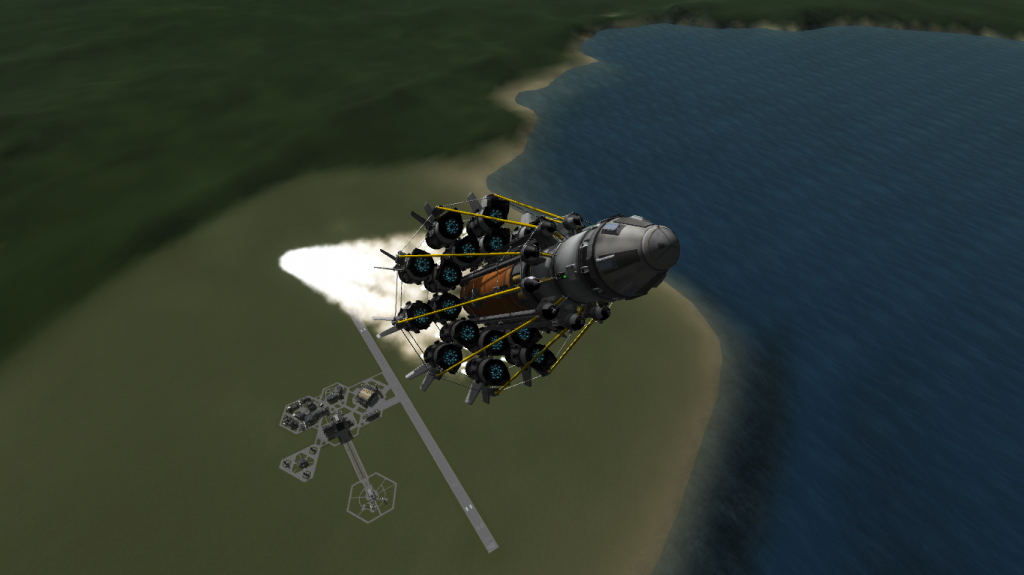
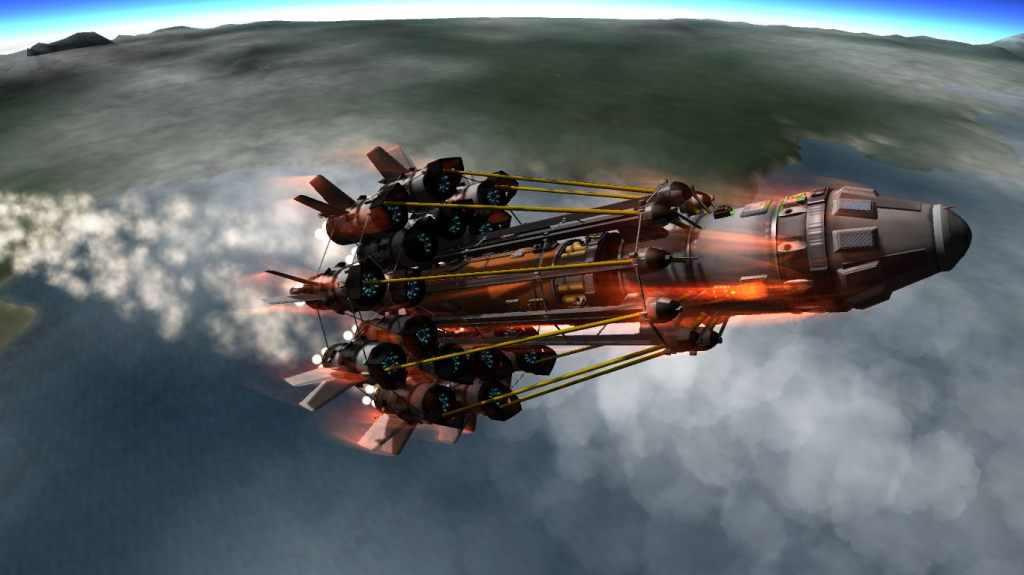

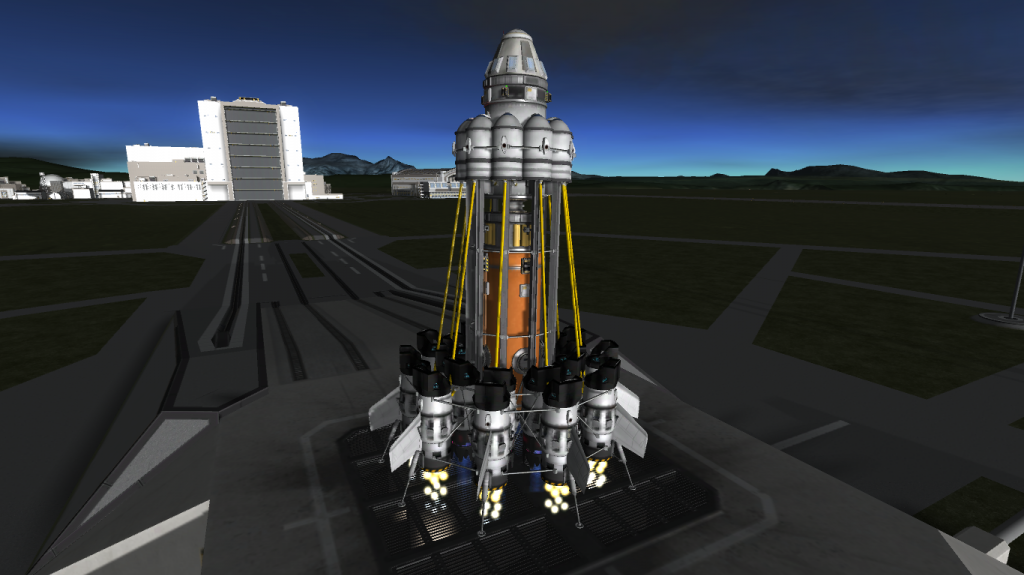
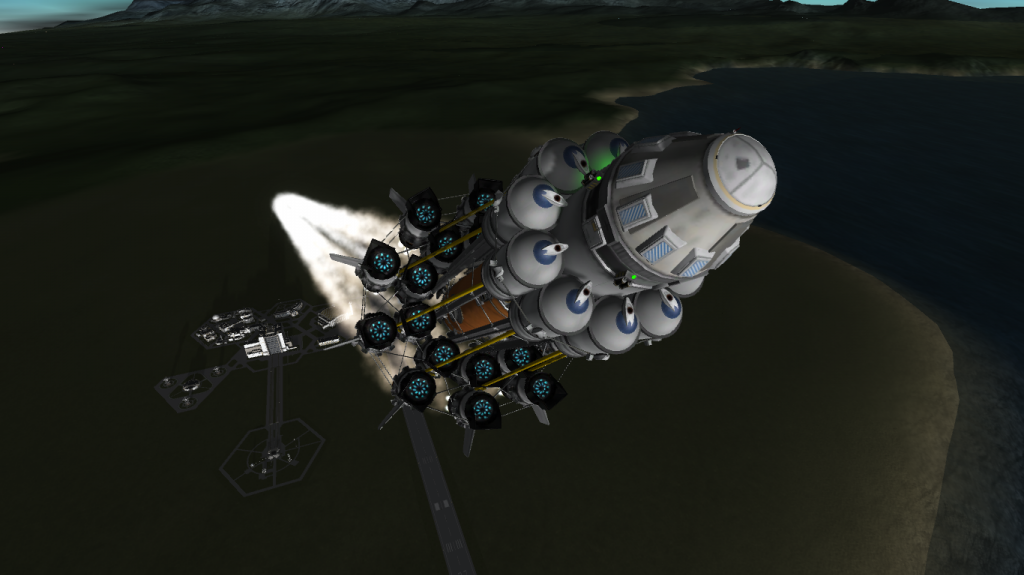
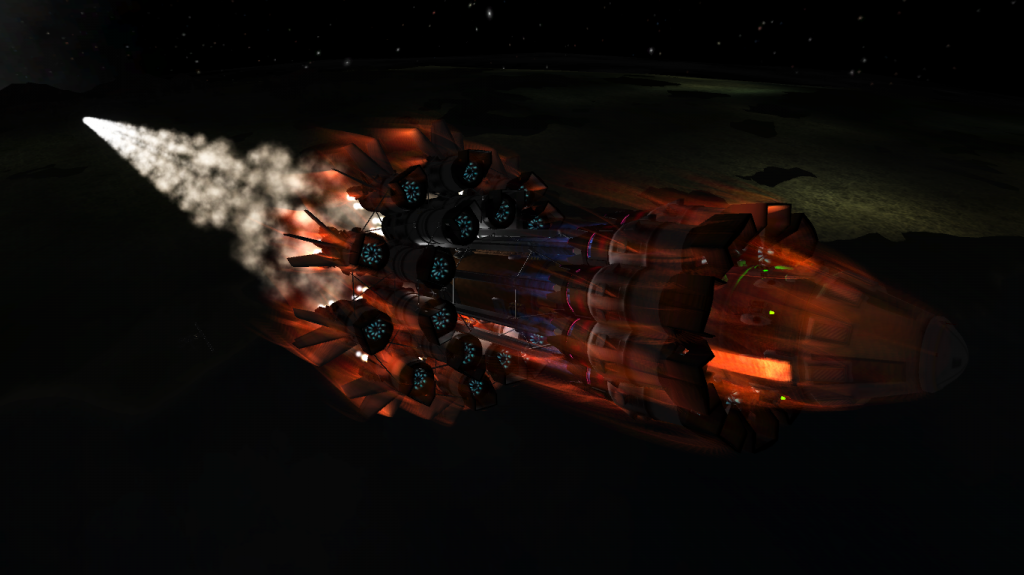
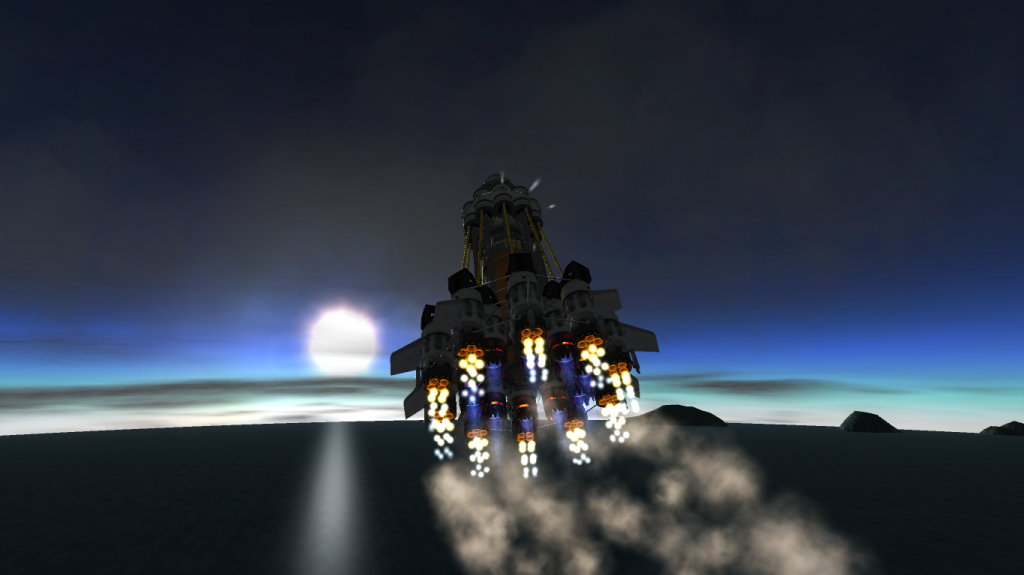
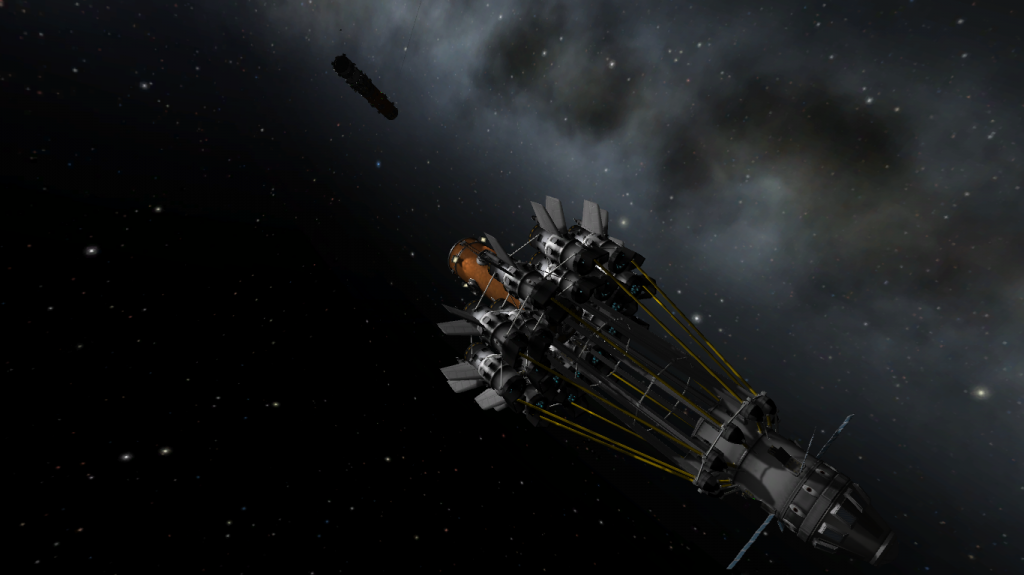
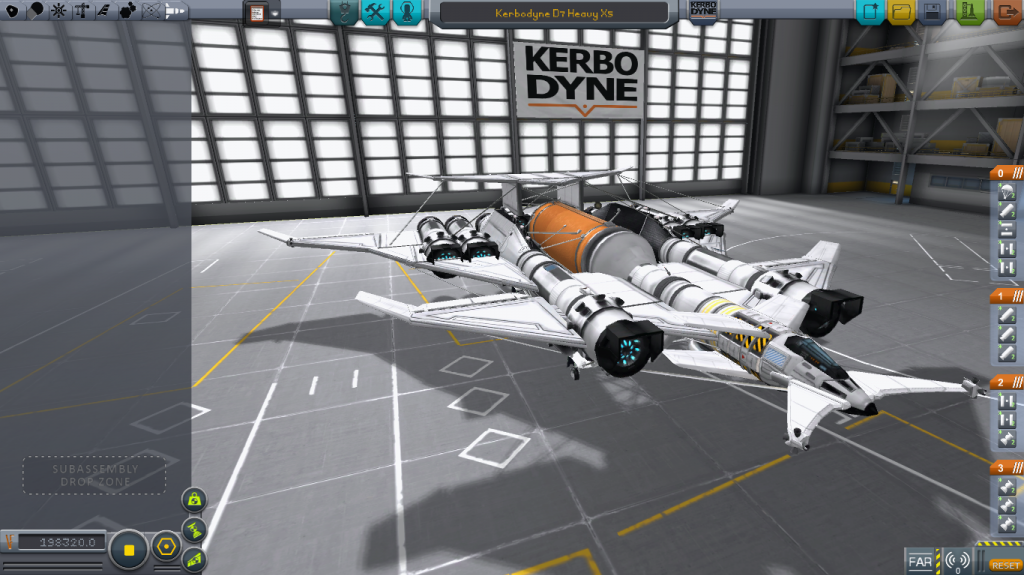
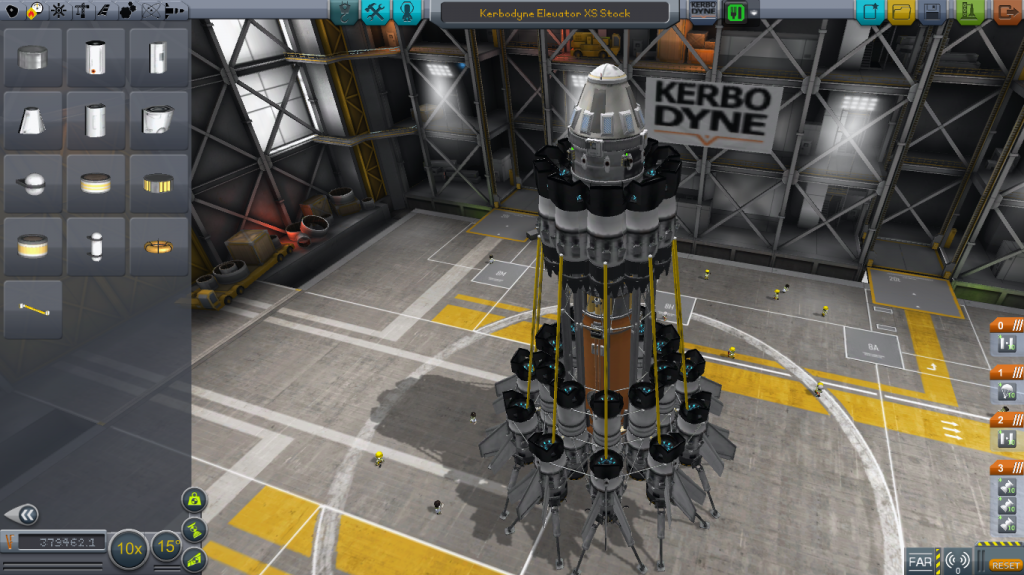


More plane fun! (and questions)
in KSP1 Gameplay Questions and Tutorials
Posted · Edited by Wanderfound
When building multi-part wings, give some thought to what you attach each bit to. Ideally, you want the whole wing connecting through a single root node so you can move it as a single piece. As for placing them, I find it helps to try and get the wing position sorted before you clutter up the plane with too many other parts that get in the way. Often, when a wing won't "go green", it's just because there's an RCS block or similar small part in the way. If all else fails, you can always use the debug menu (Alt-F12) to temporarily enable part clipping.
FAR provides assorted technical analysis tools (NEAR doesn't), but you don't need to use them. I design purely by eye and flight testing.
Heavy lift stock SSTO's are certainly possible; big ones (50+ ton payload) are tricky to build, but small to medium cargo lifters aren't too hard. If you've got enough wing and thrust to get off the runway, then you've probably got enough to go to space. See http://forum.kerbalspaceprogram.com/threads/88628-Kerbodyne-D7-Heavy-X5-a-heavy-lift-SSTO-spaceplane for an example of a heavy cargo stock SSTO spaceplane.
On a more modest scale, something like this isn't hard to build with Spaceplane Plus:
Getting spaceplanes to work for you is as much about piloting as it is building. See http://forum.kerbalspaceprogram.com/threads/89643-SSTO-question?p=1334110&viewfull=1#post1334110 for some tips.